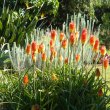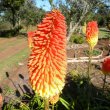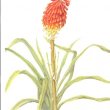| Botanical Name |
Kniphofia praecox - Hybrid |
| Family |
Xanthorrhoeaceae - |
| Pronunciation |
|
| Common Name(s) |
English: Red hot poker; Torch lily
|
| Plant Group |
- Bulb / Corm / Rhizome / Tuber / Epigeal bulb Bulbs: are made up of fleshy scales as in an onion
Corm: a short, swollen, underground stem that is hard and not fleshy as in a gladiolus
Tuber: a solid, fleshy, underground, storage organ as in a potato
Rhizome: an underground, horizontal, swollen stem at the base of the plant as in an iris
Epigeal bulb: bulbs that rest above the ground with only the roots anchoring the plant to the earth as in albuca
|
| Plant Size |
- Large
| Tree | 18m to 25m |
| Shrub | 3m to 4m |
| Perennial/ground cover | 75cm to 1m |
| Bulb | 80cm to 1.2m |
| Succulent | 1m to 1.5m |
|
| Position |
- Partial Shade The area is in shade for part of the day and in full sun for part of the day.
- Sun The area is in full sun for all or most of the day, all year round.
|
| General Information |
- Drought Tolerance: High The plant is well adapted to arid conditions; it can survive long periods of drought and high temperatures without extra water.
- Evergreen Plants that have leaves all year round.
- Frost: Hardy The plant can withstand freezing temperatures or frost without artificial protection.
- Water Wise Plant species originating from low rainfall regions that require less water to survive and thrive than other plant species.
- Wind Tolerant Plants able to withstand the effect of strong winds.
|
| Specific Information |
This hybrid has been around for a long time and is probably the image most people imagine when they think of red-hot pokers. It is a tough survivor and will grow almost anywhere, is often neglected, but will continue to flower year after year.The brightly coloured flowers enliven the garden in winter and provide welcome food supply for sunbirds and bees. Kniphofia praecox can be used at the back of a mixed flower border, in groups in the front of a shrub border, or lining a long driveway.
|
| Ad Break |
|
| Flowers |
| Description |
a thick spike 15 cm long clustered with tubular flowers, on a stout stem up to 1.2 meters tall
|
| Season |
- Winter Plants will seldom bloom for the entire season as given in the list, but should flower during a period within these parameters.
|
| Colour |
|
| Growth Rate |
- Moderate to Fast Specifying growth rate can be very misleading as there is considerable variation of growth rate depending on type and species of plant, available water, supplementary feeding, mulching and general care, as well as the plants suitability and adaptability to the garden environment.
|
| Plant Uses |
- Accent or Focal Point A plant used to attract the attention because of its colour or form.
- Attracts bees, butterflies or other insects This plant attracts insects which can be food for birds or other creatures in your garden.
- Attracts Birds This plant will attract birds.
- Border A strip of ground, at the edge of a driveway or path in which ornamental plants or shrubs are planted.
- Cut Flowers Plants that provide flowers suitable for ornamental uses.
- Filler Either a fast growing tree or shrub used temporarily to fill in an area while the permanent plants grow to a desired size, or a plant used to fill gaps in borders or beds.
- Mass Planting Plants useful for filling a large area with just one or a few kinds of plants spaced close together. Creates a bold, dramatic effect and to reduces maintenance.
- Rock Garden An area constructed of larger rocks, arranged naturally, to emphasise the use of stones as a main element. Generally plants used do not need a lot of care.
- Suitable for coastal gardens Plants adapted to dry, sandy soil, forceful wind, limited rainfall and intense sunlight.
- Water Features These plants may have dramatic, lush foliage or graceful form. They do not shed excessive leaves and do not have invasive root systems.
- Wild Garden An indigenous garden planted for the benefit of wildlife and birds. Provides food, water, a variety of mini-biomes and no poisonous chemicals are used.
|
| Distribution and Habitat |
|
| Planting Suggestions |
Kniphofia praecox prefers full sun but will tolerate a little shade. Too much shade will produce plenty of foliage but flowering will be negatively affected. Plant shallowly in rich soil or soil that has been well dug over and mixed with plenty of compost and fertiliser. They need plenty of water and some fertiliser during summer and autumn to perform at their best but will survive and flower in dry conditions. Red hot pokers should be left undisturbed for many years as they resent disturbance and will take a year or two to settle down after being divided.
|
| Medicinal Uses |
|
| Ad Break |
|











Comments
Kniphofia Praecox
Hi. Does the red hot poker's rhizomes grow when planted without leaves?
Kniphofia rhizomes without leaves
Hi Francois
I have had about 70% success with planting Kniphofia this way. This is how I do it. The rhizomes should be as fresh as possible. I break or cut off any dead, damaged or diseased root matter and let the cut dry for a day, unless the rhizomes are very dried out. I plant most of the rhizome firmly just below the soil surface with the hairy bits above the surface then mulch very lightly so as not to smother the tops of the plants. It may take quite a bit of time before signs of growth - the last lot took 2 months to start but grew quickly after that.
Pitfalls are over-watering and/or poorly drained soil causing rot, and burying the rhizome too deeply.
Regards
Lorraine
Planting KNIPHOFIA rhizomes
Thank You! I will try it.
Discuss this plant
Share knowledge, ask a question or give an experience.